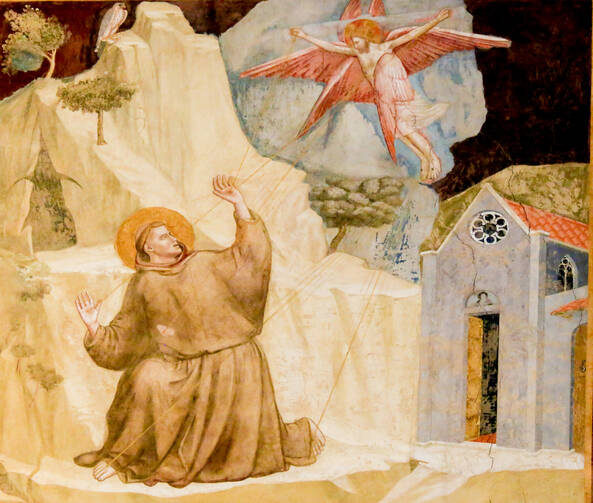Today is the feast of St. Robert Bellarmine (d. 1621), the important Jesuit bishop and theologian. Or is it?
With all respect to my Jesuit brothers and the universal church, for whom today is the memorial of St. Robert Bellarmine, the worldwide Franciscan family celebrates the feast of the Stigmata of St. Francis each Sept. 17. It has always struck me as an awkward celebration, at least at first glance. It would appear that Franciscans the world over are celebrating five wounds, celebrating the pain and suffering the we know accompanies what is sometimes billed as a great grace or gift from Christ. And it remains awkward and even weird if we remain fixated on the crucifixion wounds that appeared on Francis's body.
But this feast day actually has little to do with these wounds as such.
Rather, the feast of the Stigmata, at least theologically, is a much more complex and robust celebration. What we see when we take a closer look beyond the disputed history of hagiography and medical inquiry (numerous studies have been written about the veracity of the Stigmata accounts, most recently Solanus Benfatti's book, The Five Wounds of Saint Francis [2011]), is not a question of what appeared on the outside of the Poverello, the poor man from Assisi. Instead, we are invited to look more carefully inside, to the interior life of a Christian disciple who wished nothing more than to follow in the footprints of Christ.
This is at the heart of the Feast—a recognition that what appeared externally on Francis's body was reflective of his interior conformity to the lived example of Jesus Christ.
In his conclusion, Benfatti writes:
It is essential to comprehend that Francis had never thought to pick and choose aspects of the life of Christ to dress himself up in, but rather had chosen something that I would say is much harder because there is far less control in it: he had chosen, simply, to follow. Francis chose to move forward step-by-step in the footprints of the Lord, which I say is dangerous, because who can know where it will lead? (p. 236, emphasis original)
This is at the heart of the feast—a recognition that what appeared externally on Francis' body was reflective of his interior conformity to the lived example of Jesus Christ.
So often we are people who judge from the exterior—how someone dresses, how or what someone speaks, where someone lives, what someone does, and so on. Yet, as the Scriptures continually remind us, God judges what is inside and in our hearts. The feast of the Stigmata is a celebration of a Christian life lived as fully and authentically as possible. The "grace" that was given to Francis was not some random burden or some freak sideshow illness, it is a visual and corporeal representation of what only God can typically see—a baptized man who lived as fully as he could bearing the resemblance of Christ.
On this feast day, I invite all people—Franciscans and others alike—to look within, see how each of us does or does not bear the marks of Christ in our thoughts, words, and deeds. Perhaps we won't receive the marks of Christ in the form of five wounds, but we could certainly—and should certainly—make visible the presence of Christ in every other way.
Happy Feast Day!










